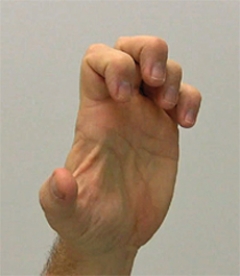A) Speed's test
B) Yergason's test
C) Ludington's test
D) Neer's test
E) Phalen's test
Correct Answer

verified
Correct Answer
verified
Multiple Choice
Where is the triangular fibrocartilage complex (TFCC) located in the wrist and hand?
A) It is interposed between the head of the ulna and the triquetral bone.
B) It is the opening of the carpal tunnel that allows structures to pass through to the hand.
C) It is interposed between the trapezoid and the scaphoid bones of the carpal region.
D) It is the tunnel under the extensor retinaculum that allows structures to pass through to the hand.
E) It is interposed between the 5th metacarpal phalangeal base and the pisiform bone.
Correct Answer

verified
Correct Answer
verified
Multiple Choice
Which of the following would be an inappropriate body structure to palpate during the palpation section of the forearm?
A) Olecranon process
B) Lumbrical muscles
C) Extensor retinaculum
D) Pronator quadrates muscle
E) Radial artery
Correct Answer

verified
Correct Answer
verified
Multiple Choice
What motion would cause pain and be indicative of a scaphoid fracture?
A) Downward pressure on the thumb
B) Upward pressure on the thumb
C) Radial flexion
D) Upward pressure on the thumb and radial flexion
E) Downward pressure on the thumb and radial flexion
Correct Answer

verified
Correct Answer
verified
Multiple Choice
Select only the appropriate steps that may be taken when releasing blood from beneath a fingernail.
A) First, coat the injured finger with antifungal cream once the hole is created.
B) Provide open wound follow-up care.
C) Use a high-temperature cautery while using moderate pressure to melt through the nail to the site of the bleeding.
D) Use a needle that has been sanitized by a burning flame.
E) First, coat the injured finger with antibiotic cream once the hole is created.
F) Use a small gauge drill to penetrate the injured nail, using a rotary action.
Correct Answer

verified
Correct Answer
verified
Multiple Choice
Which of the following deformities is caused by a palsy of the radial nerve?
A) Benediction deformity
B) Bishop's deformity
C) Claw hand deformity
D) Ape hand deformity
E) Drop wrist deformity
Correct Answer

verified
Correct Answer
verified
Multiple Choice
Please check all of the mechanisms of injury that can cause a triangular fibrocartilage complex (TFCC) injury.
A) Violent twist or torque of the wrist
B) Hyperflexion of the wrist
C) Falling on an outstretched hand
D) Repetitive ulnar deviation
E) Repetitive radial deviation
F) Crushing of the wrist by a helmet, ball, etc
Correct Answer

verified
Correct Answer
verified
Multiple Choice
A rupture of the flexor digitorum profundus is also referred to as which of the following?
A) Boutinniere deformity
B) Mallet finger
C) Jersey finger
D) Trigger finger
E) Gamekeepers thumb
Correct Answer

verified
Correct Answer
verified
Multiple Choice
Select the symptoms that are related to the injury of the forearm, wrist, hand, and fingers. Forearm Fractures
A) Pain
B) Ecchymosis
C) Hematoma
D) Swelling
E) Muscular weakness
F) Tenderness
G) Disability
H) Crepitus
I) Deformity
Correct Answer

verified
Correct Answer
verified
Multiple Choice
The diagram represents a taping technique for the wrist, hand, and fingers that could be used for which of the following problems? 
A) Tenosynovitis
B) Wrist sprain
C) Nerve compression
D) Nerve entrapment
E) Carpal tunnel
Correct Answer

verified
Correct Answer
verified
Multiple Choice
Hoffman's disease is another name for which of the following?
A) Kienbock's disease
B) deQuervain's disease
C) Wrist ganglion
D) Mallet finger
E) Triangular fibrocartilage complex injury
Correct Answer

verified
Correct Answer
verified
Multiple Choice
A tennis player has severe pain near the base of her fourth and fifth metacarpals after accidentally hitting her racket on the court after diving for a ball. What could possibly be the problem?
A) A scaphoid fracture
B) A lunate dislocation
C) A hamate fracture
D) Carpal tunnel
E) Nerve entrapment
Correct Answer

verified
Correct Answer
verified
Multiple Choice
What other injury can the forearm sustain that is much less common than in the lower leg?
A) High ligament sprain
B) Stress fracture
C) Trigger points
D) Chronic exertional compartment syndrome
E) Muscular strains
Correct Answer

verified
Correct Answer
verified
Multiple Choice
If a patient is suffering from the problem noted in the figure of the hand, which nerve would be damaged? 
A) The ulnar nerve
B) The radial nerve
C) The median nerve
D) The axillary nerve
E) The musculocutaneous nerve
Correct Answer

verified
Correct Answer
verified
Multiple Choice
Mallet finger is an injury to which of the following structures?
A) Extensor tendon avulsion
B) Flexor tendon avulsion
C) Extensor tendon strain
D) Flexor tendon strain
E) Subluxation of the flexor tendon
Correct Answer

verified
Correct Answer
verified
Multiple Choice
Select the symptoms that are related to the injury of the forearm, wrist, hand, and fingers. Forearm Splints
A) Pain
B) Ecchymosis
C) Hematoma
D) Swelling
E) Muscular weakness
F) Tenderness
G) Disability
H) Crepitus
I) Deformity
Correct Answer

verified
Correct Answer
verified
Multiple Choice
What is the most commonly fractured carpal bone?
A) Scaphoid
B) Lunate
C) Hamate
D) Trapezium
E) Pisiform
Correct Answer

verified
Correct Answer
verified
Multiple Choice
Select the symptoms that are related to the injury of the forearm, wrist, hand, and fingers. Colles' Fracture
A) Pain
B) Ecchymosis
C) Hematoma
D) Swelling
E) Muscular weakness
F) Tenderness
G) Disability
H) Crepitus
I) Deformity
Correct Answer

verified
Correct Answer
verified
Multiple Choice
If a patient complains of pain and swelling over the thumb, what type of fracture may have occurred?
A) Bennett's fracture
B) Distal phalangeal fracture
C) Middle phalangeal fracture
D) Proximal phalangeal fracture
E) Boxer's fracture
Correct Answer

verified
Correct Answer
verified
Multiple Choice
Which of the following nerves enters the palm of the hand through the carpal tunnel and supplies three of the four thenar muscles?
A) The median nerve
B) The radial nerve
C) The ulnar nerve
D) The thoracodorsal nerve
E) The subclavian nerve
Correct Answer

verified
Correct Answer
verified
Showing 21 - 40 of 45
Related Exams